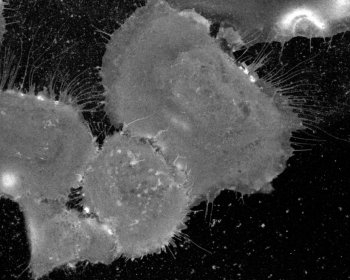West Cell Kit with 100 nm thick membranes, 200 um frames, 0.5mm window, Pack of 10 (Kit includes 1 e
| Availability | Contact for Availability |
|---|---|
| Item | 6100WC-BA |
The SPI SEM Wet Cell Kit™ is now available for those wanting to conduct back scatter electron imaging on wet samples but not having the funds for purchasing a high cost SEM with low vacuum capability. Indeed we believe the SPI SEM Wet Cell Kit™ could be used quite successfully on any SEM, one that need not have LaB6 or FESEM capabilities. The results shown on this page were done on an SEM that very definitely was not new and was equipped with a heated tungsten filament capability only.
Each Kit has 10 Wet Cells
100 nm Thick Membranes
The Concept:
Cells can be grown on the membrane just as they would on certain polymer film surfaces, such as Aclar®, polycarbonate, etc. And once the cells are processed (e.g. fixed) and washed, another cell can be glued to the first one creating a chamber that has the volume of two membrane window grids. But since this is in fact more volume than is actually needed, for the back side a blank silicon disc can be glued down instead. The seal must be vacuum compatible of course.
The Results:
Nothing but spectacular! The silicon nitride membrane window is thinner than a polymer membrane, which is the reason for the results that are quite spectacular when compared to the results obtained using systems that employ polymer membranes.
Experimental Details:
All results shown on this webpage were from Cos 7 cells grown onto 100 nm thick silicon nitride membrane window grids, specifically, SPI #4122SN-BA.
The cells were grown overnight at 37°C (98.6° F) in an incubator in a chamber consisting of an internally threaded aluminum cylinder epoxied to the membranes. Aluminum material was coated in carbon prior to adhering the membrane. The cells were then fixed in glutaraldehyde and OsO4 washing thoroughly with phosphate buffer after each step. Twenty micro litres of dextran loaded phosphate buffer were then added and the silicon nitride membrane window cell sealed.
Selection of The Right Membrane Thickness:
For this application, thinner is definitely better. The thinner the membrane, the higher will be the resolution. The micrographs taken for the website presentation we done using 100 nm membranes but there is no doubt in our minds that if thinner membranes were selected, that far more information would be available from images that would be of demonstrably higher resolution. The thinner the membrane the better the quality of the data but also, the thinner the membrane the more likely one might be to rupture the membrane. Therefore we offer the Wet Cell Kits in a selection of different membrane thickness and we leave it to our customers to decide which is best for them. We also offer a "sampler" kit that includes 2 each of four different membrane thicknesses (e.g. 100 nm, 50 nm, 30 nm and 20 nm) plus 8 "blanks" so that there would be enough material to make a total of 8 different Wet Cells.
Silicon Disc "Blanks"
Instead of using for the "backing" another membrane window grid, we recommend using a silicon "blank". This is literally a piece of silicon from the same thickness wafer but without the etch pit or hole. Hence when handling the cell, you need to worry about not touching just one of the two sides. Using a blank results in a far more robust system and one far less likely to rupture when handling or processing.
Special Adhesive:
In theory, one can use a whole range of different adhesives for gluing together the two different silicon "sides", one being the membrane window grid and the other, a silicon "blank", including our own 5-minute epoxy glue. But we would recommend a particular SPI # 6000WCG-AB, for this purpose since it is much more high vacuum compatible. One unit of this adhesive, more than enough to glue ten cells, is included with each kit.
Wet Cell™ Kits
Each kit contains ten membrane grids of the stated membrane thickness plus 10 blanks to make a total of 10 different SEM wet cells plus one pack of the special 3M® Brand DP 460 adhesive to glue the two sides of the cell together:



